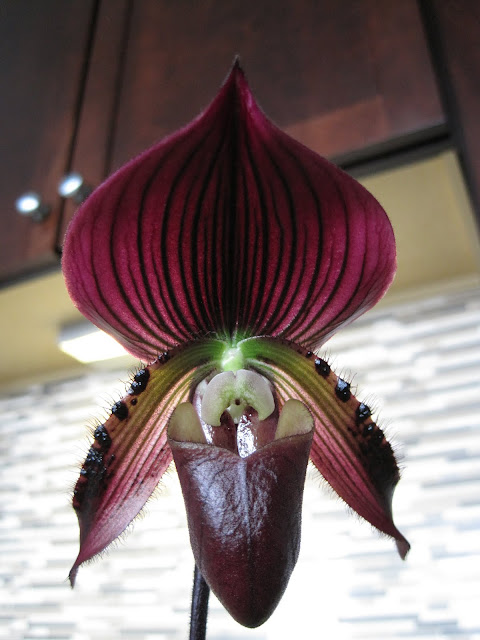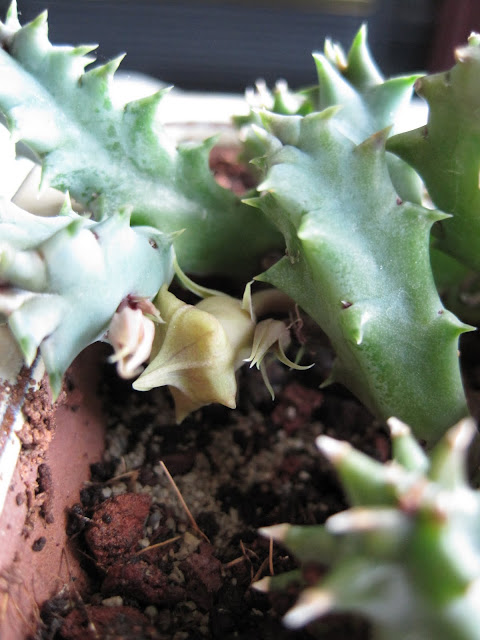Behold, the reason for my infrequent posts!
The dreaded mealybug!! (Gasp! Boo! Hiss!)
Pseudococcidae. I can think of few other pests that beleaguer indoor gardeners as frequently and as tenaciously as the mealybug...except maybe spider mites. Maybe it's a tie, and they both lose.
I had my first experience with mealybugs last year when I took home a beautiful
Maranta (prayer plant), and found it to be exploding with white fuzzy stuff within a month. A more experienced gardener would have probably tossed out the plant, but I have a painful twinge of guilt every time I do that and avoid this as much as possible. So, I learned the hard way that one can conquer these bugs, rather than acquiesce to the hostile takeover, although it usually involves more trouble than it is worth. More on how to do this later.
My prayer plant (Maranta leuconeura var. erythroneura)...its leaves fold up at night when it gets tired, and it looks like it is praying. The backs of the leaves are a pretty maroon. The leaf tips got a bit crispy this winter, as it was dry in the condo. I probably should just go ahead and prune it back anyway...
Anyhoo, I purchased a wonderful little
Huernia species (labeled
Huernia insigniflora, but I think it is probably
Huernia confusa) off of e-bay, and unlike any conscientious gardener, of course I did NOT quarantine it. In fact, like a moron, I noticed several mealybugs on it after I unwrapped the bare root plant, promptly killed them with the time-honored rubbing alcohol on a Q-tip method, AND THEN I STILL PUT IT WITH MY OTHER SUCCULENTS. Yes, I know. I deserved what happened next.

This very little plant belongs to an interesting group of Asclepiadoideae called the Huernias. Same family as the Stapelias and Duvaliandras, of which I am so fond. Huernias tend to be short plants with thick, succulent, clumping stems with fleshy tubercles that look like spines. Not sharp, and with no glochids to hurt you, feel free to cuddle with them as you see fit. In going with their brothers and sisters, huernias have also evolved to attract flies for pollination, although with slightly smaller and less smelly blooms. Interestingly, many have a very well developed central ring, or annulus, that has contributed to the common name, "lifesaver plant."
Here is mine: (MUGSHOT: MEALYBUG VECTOR AND BRINGER OF PESTILENCE)
Note the tiny bud at right...
This cute little guy started off all fun new growth and promising little flower buds, but soon became the harbinger of doom and broken promises. Within several weeks, I noticed my poor Stapelia scitula (see previous posts) which had previously been going gangbusters and constantly putting out new blooms seemed to surreptitiously go dormant. A few tiny mealybabies started showing up on the Huernia, and all flower buds quickly shriveled. Within days, the Stapelia was consumed within a swarm of soft, fluffy mounds of pediculosis.
I have learned that one can do fairly well in eradicating mealybugs with Q-tips dipped in rubbing alcohol. The alcohol seems to melt away their fluffy, powdery white encasements and shrivels the underlying bug. You can almost hear the nasty little devils screaming their rage at being sent back to the hell that spawned them. While immediately gratifying, this method is time consuming as you have to kill every bug and egg casing individually--and the little rascals are very adept at hiding. Alternatively, Imidacloprid is a nice systemic mealy-killer (I use Bonide). You just sprinkle it in the dirt, and every time you water, your juicy little succulent becomes a sponge for the toxic chemical, and the mealybugs don't know what hit 'em. Fortunately, I have found that my succulents have all tolerated the imidacloprid without any apparent side effects.
Behold, Ye Holy hand grenade:

So, as of today, there are no more mealybugs readily visible anywhere, and after several weeks of dormancy the Stapelia scitula is growing and putting out flower buds again. The future of the Huernia confusa is less certain, however. For some reason, the buds keep blasting...(bud blast means that a flower bud dies before fully flowering). I'm tempted to throw it out and look for a new one. Maybe it only blooms later in the Summer, and has fake-out buds early on....hrrmmm.....stay tuned!













